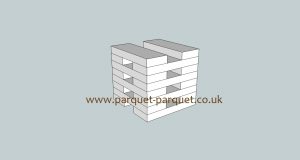Acclimatising parquet before laying it is really important to the end results of a reclaimed floor. The relative humidity ( rh ) between the blocks and your ambient room temperature matters. If the blocks are too high in humidity and you run your heating quite high, there will be shrinkage and gaps. That is, unless you get that relative humidity much closer before you get your floor fitted.
The wood type is also important because each species expands and contracts differently. Each wood type has a classification of the amount of ‘movement in service’. This means that anything that is small movement in service is less susceptible to shrinkage that something with medium movement in service. An example would be Oak, which has a medium movement in service and normally benefits from acclimatisation. If you selected Rhodesian Teak for example, there is minimal movement in service so acclimatisation is less critical but can still be good practice.
Our parquet is stored in unheated sheds so when blocks are brought into the house they need to match the humidity of their environment. Acclimatising parquet is usually for at least 2 weeks duration in the place it is due to be fitted. It is best to ensure the parquet is spaced out so that air can circulate around each block. Do not stack in one big lump otherwise there will be no benefit to the blocks in the centre. If you can, spread the blocks in stacks around the room. If not practicable, then allocate a space and stack high!
Below are a few images for you to see what the best method is for acclimatising parquet.
Stacking your blocks:
When your parquet arrives, it helps to stack in Jenga columns. Preferably around the room where possible. The image below shows small but very effective stacks.





